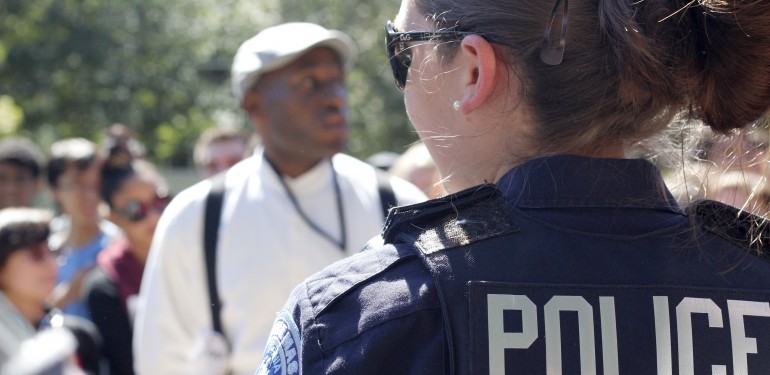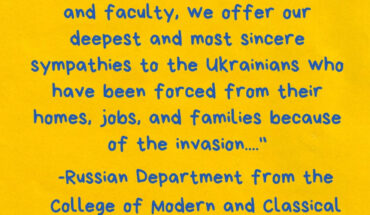University law enforcement agencies are able to receive surplus military gear through a program with the Department of Defense.
Many college police departments have used the program since its creation in the late 1990’s. It is called the 1033 program, or the Domestic Preparedness Support Initiative and allows the surplus military equipment to come at a dramatically reduced price. In addition to college police departments, the program is available to any local, state or federal law enforcement agency.
President Obama ordered a review of the program after the local police response to protesters in Ferguson, MO included heavy-armored trucks and other equipment obtained through the program.
According to Mason Police Chief Eric Heath, the Mason Police Department has rarely used the program. Heath said, to the best of his and his staff’s knowledge, the department has used the program only once, several years ago, to acquire ceremonial rifles for an Honor Guard event.
“What they got was de-commissioned ceremonial rifles, so rifles that were de-commissioned, meaning they’re non-functional, and they’re transitioned and repainted and fixed up to be used for our Honor Guard.”
At a hearing, as part of the review ordered by President Obama, federal supervisors of the program admitted “they had no way to track any ‘military-grade’ equipment supplied by the government,” said a USA Today article. In order to obtain data concerning law enforcement agencies’ use of the program, news outlets have had to rely on data provided by states.
Colleges like Ohio State University are drawing media attention due to their acquisition of equipment such as a Mine-Resistant Ambush Protection vehicle and an Army Humvee. However, according to a Politico article, the program also supplies items like office supplies and furniture.
Heath pointed out some ways the program has been beneficial to law enforcement.
He said many local or campus police departments are “barely getting by with their operating budgets, so that kind of a program can benefit those agencies who normally would not be able to shell out $15,000 to equip their department with rifles to deal with active shooter situations.”
Heath has worked for law enforcement departments at the University of Chicago, Vanderbilt University, and the University of Arkansas. He said most of the agencies that he has worked for that have used the 1033 program, have used it to obtain a version of M-16 rifles for active shooter situations.
“The majority of departments that I’ve had experience with generally get rifles and have the ability to get rifles they may use for an active shooter situations,” Heath said. “That really kind of changed the landscape of college law enforcement, with all of your most recent active shooter situations…transitioned the type of weapons they used in those situations.”
The rifles, Heath said, were altered to suit the functions and necessities of local law enforcement. For example, M-16s were altered so the guns were no longer semi-automatic.
Heath said he would consider using the program if it helped campus law enforcement best serve the Mason community.
“In the future, if I felt or my leadership felt there was some way we could benefit from the program, us and other law enforcement agencies would absolutely look into it,” Heath said. “But it has to be reasonable. It has to cater to the community that we serve.”
A spokesman for Ohio State University has cited the school’s population size, approximately 57,000 students, as one reason that justifies possession of a Mine-Resistant Ambush Protection vehicle. Though Mason is the largest public university in Virginia, Heath said Mason PD has no need for such a vehicle.
“It really just depends on agency,” Heath said. “Size doesn’t necessarily dictate as to whether or not you get that type of equipment. It really depends on the function of the agency.”
For example, OSU’s Ohio Stadium hosts many large sporting events and can seat over 100,000 people. Heath said that creates potentially threatening situations that Mason does not usually have to deal with.
“From a threat standpoint, that’s a very large target in preparation for emergency management and threat management,” Heath said. “Some of those tools and some of those resources are necessary to be able to cope with an incident that might occur. Now, is a tank good for Mason, or a Humvee good for Mason? Probably not because we don’t have those large scale venues.”
Other local and campus law enforcement agencies in Virginia have used the program more extensively than Mason.
A local Charlottesville news station reported that “Since 2006 Charlottesville police have accepted hundreds of thousands of dollars in de-commissioned military cast-offs, including 96 5.56 mm rifles, 40 pieces of night vision equipment, and even an armored truck.”
According to an article from The Chronicle of Higher Education, James Madison University has received one copier, one typewriter, eight entrenching tools, two printers, three trucks and four shotguns.
Heath explained that determining the necessity of surplus military equipment is the responsibility of local and campus law enforcement leaders.
“The onus is on the chiefs and the leadership to really look at the department, the structure of the department and the function of the department, and say, ‘You know what, is that something I really need for my community?’’
“Me personally, and I know my leadership personally, we’re not going to go out and just acquire equipment just because the government is giving it away,” Heath continued. “It has to be functional for our jurisdiction.”
This story was originally published in the Oct. 6 issue of Fourth Estate. Photo Credit: Amy Rose




